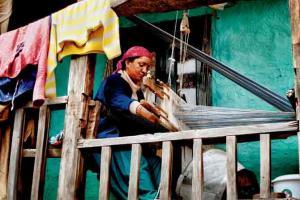Home / Sunday-mid-day / / Article /
Vocal weaver, no more?
Updated On: 22 September, 2021 02:38 PM IST | Mumbai | Jane Borges
The governments decision to scrap the handloom and handicraft boards is seeing betrayed weavers and co-operatives say they need representation before marketing

A woman works on a loom in the balcony of her home in the village of Old Manali in Himachal Pradesh. The abolishing of the All India Handloom and Handicraft Boards have left many weavers disillusioned
The Ministry of Textile`s Twitter handle has seen a flurry of activity, all through August. #Vocal4Handmade, a hashtag championed by Smriti Irani, Union Minister for Textiles and Women and Child Development, to spread awareness about the handicraft tradition, has also become a cri de coeur to support the average Indian weaver. Every day, a string of posts shared by the ministry, lists names of award-winning weavers, their body of work, credentials and direct contact numbers for interested buyers. This is supplemented with photographs of their designs. Mini videos made by organisations, including the Fashion Design Council of India—retweeted by the ministry—showcase everything from the Lepcha weave of Sikkim to the Telia Rumal from Telangana.
The official handle, for all good reasons, has now transformed into an encyclopaedia on handloom, of sorts. The more you scroll, the more there is to learn and find.



